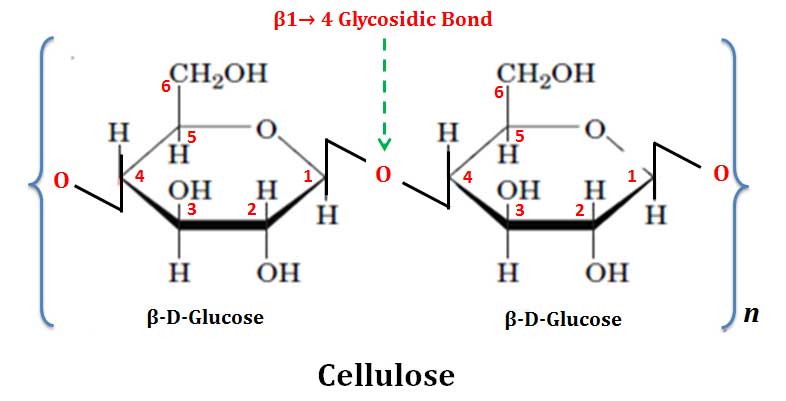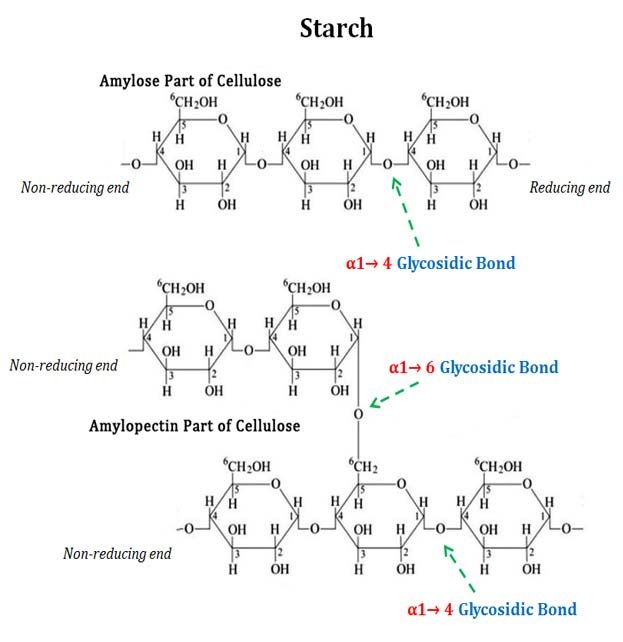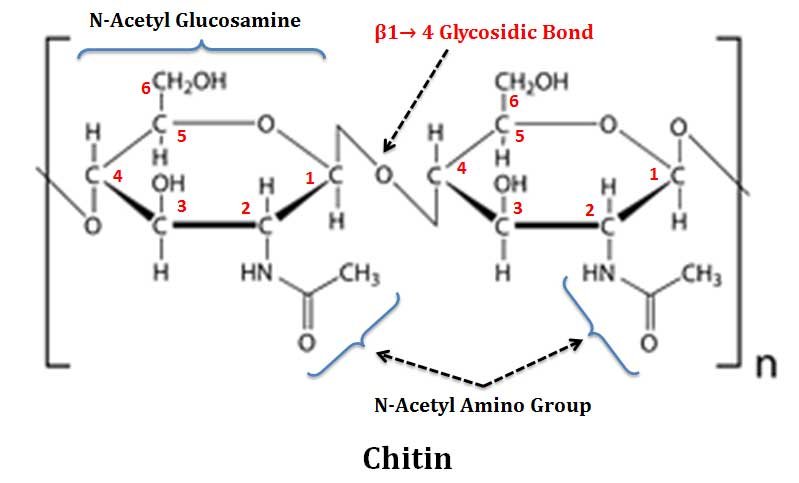What are Polysaccharides?
Carbohydrates with more than 20 monosaccharide units are called polysaccharides. Majority of carbohydrates in nature occurs as polysaccharides. Usually polysaccharides have hundreds or thousands of monosaccharide units. Monosaccharide units are joined by characteristic glycosidic bonds. In this post we will discuss the Structure, Classification and Examples of Polysaccharides.
Table of Contents
$. Classification of Carbohydrates
$. Examples
@. Cellulose
@. Starch
@. Glycogen
@. Chitin
@. Peptidoglycan
@. Inulin
@. Arabinoxylans
@. Glycosaminoglycans
$. Why Cells Prefer Polysaccharide as Storage form of Food
Classification of Polysaccharides
Ø Some polysaccharides are linear chains (Cellulose), while others are branched (Glycogen, Starch). Starch, Glycogen and Cellulose consist of monosaccharide unit – D-glucose. The term Glycans is used to denote polymers of medium to high sized carbohydrates.
Ø Polysaccharides differ in:
$ Composition (monomer units)
$ Type(s) of glycosidic bond
$ Chain length
$ Branching pattern
Ø Polysaccharides can be divided into TWO classes based on its function:
$ Storage polysaccharides (Starch in plants, Glycogen in animals)
$ Structural polysaccharides (Cellulose in plants, Chitin in insects)
You may also like NOTES in...
BOTANY BIOCHEMISTRY MOL. BIOLOGY
ZOOLOGY MICROBIOLOGY BIOSTATISTICS
ECOLOGY IMMUNOLOGY BIOTECHNOLOGY
GENETICS EMBRYOLOGY PHYSIOLOGY
EVOLUTION BIOPHYSICS BIOINFORMATICS
Ø Polysaccharides are divided into two groups based on composition:
$ Homo-polysaccharides (single type of monomer)
$ Hetero-polysaccharides (different type monomers)
Ø Storage polysaccharides are usually homo-polysaccharides.
Ø Structural polysaccharides include both homo- & hetero-polysaccharides.
Ø Hetero-polysaccharides provide extracellular support to the organisms of all kingdoms
Ø Polysaccharides are synthesized enzymatically by the cells.
Ø Unlike proteins, polysaccharides generally do not have definite molecular weights.
Ø Proteins are synthesized on a template (messenger RNA) of defined sequence and length, by enzymes that follow the template exactly.
Ø There is NO template for the synthesis of polysaccharides in the cell.
Ø Thus, there is NO specific stopping point in the biosynthesis process; hence, the size of polysaccharide greatly varies.
Examples of Polysaccharides
$ Storage Polysaccharides: Starch, Glycogen, Galactogen and Inulin
$ Structural Polysaccharides: Cellulose, Chitin, Pectins, Peptidoglycan, Arabinoxylans
(1). Cellulose
Ø Cellulose is a structural polysaccharide.
Ø It is the most abundant carbohydrate in nature.
Ø It is a linear, un-branched homo-polysaccharide of β-D glucose.
Ø Glucose molecules are linked by β1→ 4 glycosidic linkages.
Ø Cellulose is fibrous, tough and water insoluble.
Ø It is found in the cell wall of plants.
Ø The cotton is almost pure cellulose.
Ø Cellulose accounts for about half of carbon in the biosphere.
Ø About 1015 kg cellulose is produced per year by plants.
Ø In cellulose, the glucose molecules are in β configuration.
Ø Cellulose on hydrolysis yields glucose monomers.
Ø Fungi and Bacteria can produce cellulases enzyme to hydrolyze the cellulose to release glucose residues.
Ø Humans and animals lack the enzyme to break the beta-linkages (β-amylase), so they do not digest cellulose as a carbohydrate source.
Ø Certain animals such as termites, cows etc. can digest cellulose because they possess some bacteria in their gut which produces cellulose enzyme.
Ø Cellulose chains are fully extended flat ribbons like.
Ø This extended nature is due to the β-conformation of glucose residues.
Ø Successive glucose rings are turned over 180° with respect to each other.
Ø This permits the C3—OH group of each glucose residue to form a hydrogen bond with the ring oxygen of the next residue.
Ø Parallel cellulose chains form sheets with inter-chain hydrogen bonds.
Ø Stacks of these sheets are held together by hydrogen bonds and van der Waals interactions.
Ø This highly cohesive structure gives cellulose fibers exceptional strength and makes them water insoluble despite their hydrophilicity.
Ø A cellulose fiber consists of ∼40 parallel, extended glycan chains.
Ø Each glucose units in a chain is rotated 180° with respect to its neighboring residues and is held in this position by intra-chain hydrogen bonds.
Ø The glycan chains line up laterally to form sheets.
Ø These sheets stack vertically so they are staggered by half the length of a glucose unit. The entire assembly is stabilized by inter-molecular hydrogen bonds
Ø In plant cell walls, the cellulose fibers are embedded in and cross-linked by a matrix containing other polysaccharides and lignin (a phenolic polymer.)
Ø The resulting composite material can withstand large stresses because the matrix evenly distributes the stresses among the cellulose reinforcing elements.
Ø The difficulty of removing these other substances, however, is one of the main reasons that the cellulose in wood and agricultural waste, despite its abundance, cannot be easily converted to biofuels.
Ø Vertebrates themselves do not possess an enzyme capable of hydrolyzing the β(1→4) linkages of cellulose
Ø However, the digestive tracts of herbivores (and termites) contain symbiotic microorganisms that secrete a series of enzymes, collectively known as cellulases, that can hydrolyze cellulose
(2). Starch
Ø Starch is a homo-polysaccharide of α-D-glucose
Ø It is a storage polysaccharide
Ø It is a long branched polysaccharide.
Ø Starch contains 2 types of polymer : amylose and amylopectin
$ Amylose chain (20 – 25%): Long, un-branched chain, composed of glucose molecules joined by α1→4 glycosidic linkage.
$ Amylopectin chain (75 – 80%): Long, highly branched and composed of glucose molecules joined by α1→4 glycosidic linkage
Ø The branches are in α1→6 glycosidic linkage.
Ø Branch points occur at every 24 to 30 residues.
Ø α-amylose is an isomer of cellulose, however, it has very different structural properties.
Ø Cellulose’s β-glycosidic linkages cause it to assume a tightly packed, fully extended conformation
Ø Whereas, α-amylose’s α-glycosidic bonds cause it to adopt an irregularly aggregating left-handed helically coiled conformation
Ø This helically coiled conformation, amylose can accommodate iodine molecules in the helix to produce an intense blue colour (iodine test)
Ø Plants synthesize starch as their main energy reserve.
Ø Starch is deposited in chloroplasts of plant cells as insoluble granules.
Ø Storage of glucose as starch greatly reduces the large intracellular osmotic pressure that would result from its storage in monomeric form, because osmotic pressure is proportional to the number of solute molecules in a given volume.
Ø Starch is a reducing sugar
Ø Both amylose and amylopectin possess a single reducing site at the end called reducing end
Ø Digestion of starch (main carbohydrate source) begins in the mouth.
Ø Saliva contains an α-amylase enzyme (salivary amylase), which randomly hydrolyzes the α (1→4) glycosidic bonds of starch.
Ø Starch digestion continues in the small intestine under the influence of pancreatic amylase, which degrades starch to a mixture of small oligosaccharides.
Ø Further hydrolysis by an 𝛂-glucosidase, which removes one glucose residue at a time, and by a de-branching enzyme, which hydrolyzes α(1→6) as well as α(1→4) bonds, produce monosaccharides that are absorbed by the intestine and transported to the bloodstream.
(3). Glycogen
Ø Glycogen is the major storage polysaccharide in animal cells.
Ø It is a polymer of α1-4 linked glucose with α1-6 branching.
Ø Structurally glycogen is similar to amylopectin part of the starch.
Ø Different from amylopectin: glycogen is heavily branched
Ø In glycogen, branching occurs at every 8 to 12 residues.
Ø Thus, glycogen is more compact than starch.
Ø Glycogen is present in all cells, prevalent in skeletal muscle and in liver
Ø Glycogen is stored in the liver of animal, stored as granules.
Ø Glycogen constitutes 7% of the wet weight of hepatocytes.
Ø Glycogen is degraded by Glycogen phosphorylase enzyme, which phosphorolytically cleaves glycogen’s α(1→4) bonds sequentially inward from its non-reducing ends.
Ø Glycogen’s highly branched structure, which has many non-reducing ends, permits the rapid mobilization of glucose in times of metabolic need.
Ø A glycogen molecule with n branches has n + 1 non-reducing ends, but only one reducing end.
Ø The α(1→6) branches of glycogen are cleaved by glycogen debranching enzyme.
Why not cells store glucose in its monomeric form?
Ø This session describes why the cells prefer to store the carbohydrates as polysaccharides rather than monosaccharaides (glucose).
Ø Hepatocytes store glycogen equivalent to a glucose concentration of 0.4 M.
Ø The actual concentration of glycogen, which is insoluble and contributes little to the osmolarity of the cytosol, is about 0.01 μM.
Ø If the cytosol contained 0.4 M glucose, the osmolarity would be threateningly elevated, leading to osmotic entry of water that might rupture the cell.
Ø Furthermore, with an intra-cellular glucose concentration of 0.4 M and an external concentration of about 5 mM (~blood glucose level of a mammal) the free-energy change for glucose uptake into cells against this very high concentration gradient would be prohibitively large.
(4). Chitin
Ø Chitin is a linear homo-polysaccharide of N-acetyl glucosamine in β1-4 linkage.
Ø It is difference from cellulose: the hydroxyl group at C-2 is replaced by an acetylated amino group.
Ø Chitin is the principle component of the cell wall of fungi.
Ø Chitin also forms the exo-skeleton of arthropods.
Ø Chitin is not digested by animals.
Ø Chitin is the second most abundant polysaccharide in the biospehere.
(5) Peptidoglycan
Ø Peptidoglycan is the rigid component of bacterial cell wall.
Ø It is a linear hetero-polysaccharide interlinked by short peptide chains.
Ø The carbohydrate part is the alternating N-acetylglucosamine and N-acetylmuramic acid with β1-4 glycosidic linkages.
Ø The carbohydrate polymer stays side by side in the cell wall, which is then cross linked by short peptide chains.
Ø The peptide cross link cover the entire cell wall.
Ø Peptide link helps polysaccharide to form a strong sheath around bacterial cell.
Ø Lactic acid group of N-acetylmuramic acid forms an amide bond with a D-amino acid–containing tetrapeptide to form the peptidoglycan repeating unit
Ø Peptide cross link consists of both D and L amino acids.
Ø Usually the peptide sequence is L-Ala:D-Glu:L-Lys:D-Ala.
Ø The enzyme Lysozyme hydrolyzes the β1-4 linkage of peptidoglycan.
Ø Lysozyme (in tears) works as a defense against bacterial infection of eye.
Ø Penicillin kills bacterial by preventing synthesis of the cross links peptidoglycan (by inhibiting the enzyme transpeptidase)
(6) Inulin
Ø Inulin is a group of naturally occurring polysaccharides of many plants.
Ø Industrially inulin is most often extracted from chicory.
Ø Inulin belongs to a class of dietary fibers known as fructans.
| You may also like... | ||
|---|---|---|
| NOTES | QUESTION BANK | COMPETITIVE EXAMS. |
| PPTs | UNIVERSITY EXAMS | DIFFERENCE BETWEEN.. |
| MCQs | PLUS ONE BIOLOGY | NEWS & JOBS |
| MOCK TESTS | PLUS TWO BIOLOGY | PRACTICAL |
Ø It is a storage polysaccharide of plants typically found in roots or rhizomes.
Ø Most plants that synthesize and store inulin do not store other forms of carbohydrate such as starch.
Ø Storage carbohydrate present in more than 36,000 species of plants, including wheat, onion, bananas, garlic, asparagus, Jerusalem artichoke, and chicory
Ø Inulin is used as energy reserve and for regulating cold resistance in plants.
Ø Because, inulin is soluble in water, so, it is osmotically active.
Ø Certain plants can change the osmotic potential of their cells by changing the degree of polymerization of inulin molecules by hydrolysis.
Ø By changing osmotic potential without changing the total amount of carbohydrate, plants can withstand cold and drought during winter periods.
Ø Inulin is a heterogeneous collection of fructose polymers.
Ø Consists of chain of repetitive fructose moieties with terminating glucose which are linked by β(2→1) bonds.
Ø The degree of polymerization (DP) of standard inulin ranges from 2 to 60.
Ø Because of the β(2,1) linkages, inulin is not digested by enzymes in the human alimentary system, contributing to its functional properties: reduced calorie value, dietary fiber, and prebiotic effects.
(7) Arabinoxylan
Ø Arabinoxylan is a structural polysaccharide.
Ø It is a type of hemicellulose, found in the primary and secondary cell wall of plants.
Ø It is copolymer of two pentose sugars: arabinose and xylose.
Ø Arabinoxylan chains contain a large number of 1,4-linked xylose units. Many xylose units are substituted with 2, 3 or 2,3-linked arabinose residues
(8). Glycosaminoglycans (GAG)
Ø Glycosaminoglycans are the hetero-polysaccharides of ECM.
Ø ECM: ECM is filled with a gel like material. It is the ground substance which holds adjacent cells. ECM gives porous pathway for nutrients and oxygen.
Ø Glycosaminoglycans are unique to animals and bacteria and are NOT found in plants.
The Structure, Properties, Classification and Examples of Glycosaminoglycans (GAGs) are described in a separate post
References
@. Lehninger A.B., (2018), Textbook of Biochemistry, Ed. 5, Pearson International, New York
@. Voet, D., Voet, J.G. and Pratt, C.W., 2013. Fundamentals of biochemistry: life at the molecular level (No. 577.1 VOE).
Do you have any Queries? Please leave me in the Comments Section below.
I will be Happy to Read your Comments and Reply.
<<< Back to Biochemistry Notes Page
You might also like…
Introduction to Carbohydrates | Monosaccharides | Disaccharides | Polysaccharides | Glycosaminoglycans | Sugar Derivatives | Glycoconjugates
More Lecture Notes from Easy Biology Class…
BotanyZoologyBiochemistryGeneticsCell & Molecular BiologyBiotechnologyPhysiology & EndocrinologyPlant PhysiologyMicrobiologyImmunologyEmbryologyEcologyEvolutionBiophysicsResearch MethodologyBiostatisticsChemistry for BiologistsPhysics for Biologists
Browse more in Easy Biology Class…
Lecture NotesBiology PPTsVideo TutorialsBiology MCQQuestion BankDifference betweenPractical AidsMock Tests (Online)Biology Exams






Write down the structural formula of sugar moiety of DNA
Please make all notes to download it would be helpful for many students
please, provide all notes in without internet also. so that, we can print that pdf and read that without pressure to eyes